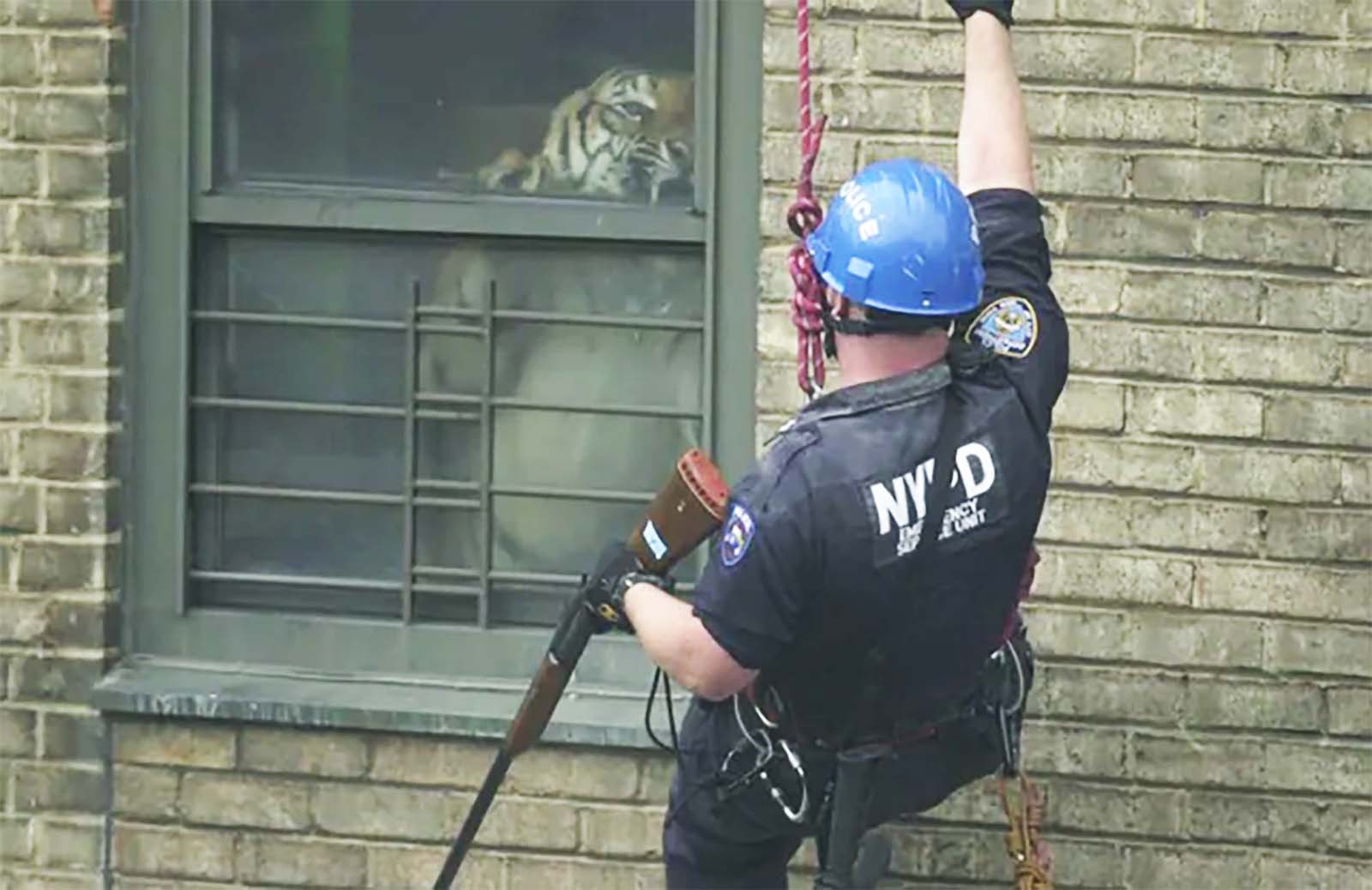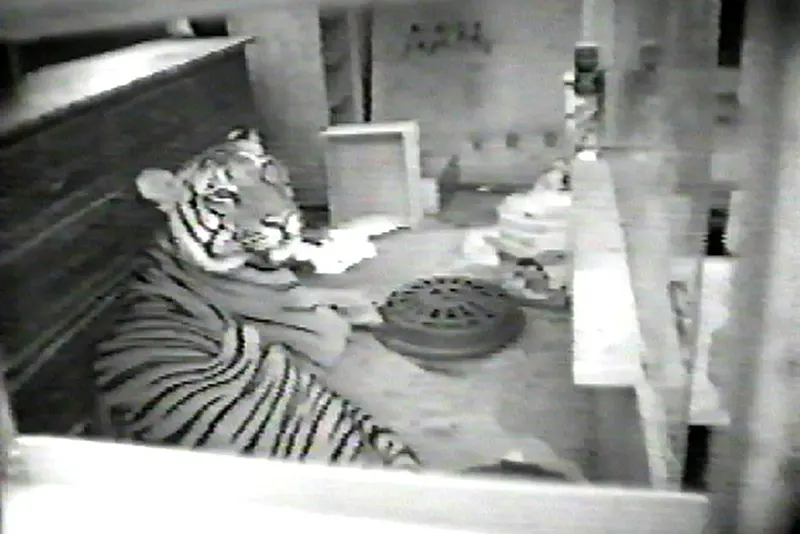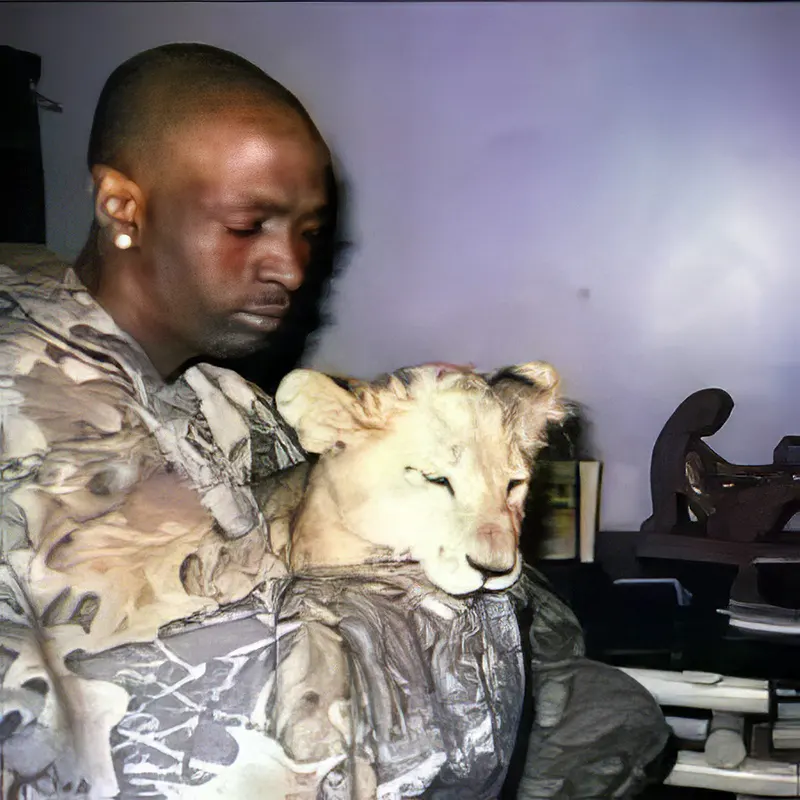 In the heart of Harlem, where crowded apartment blocks echo with the sounds of city life, few would have imagined that one of those units hid a living jungle inside.
In the heart of Harlem, where crowded apartment blocks echo with the sounds of city life, few would have imagined that one of those units hid a living jungle inside.
Every day, Antoine Yates, a tall and quiet man known in the neighborhood as a part-time cab driver, came home carrying bags stuffed with raw chicken.
His neighbors would joke about his odd diet, wondering how one man could eat so much meat. No one suspected the truth—that behind his apartment door lived a 425-pound Siberian-Bengal tiger named Ming.
From 2000 to 2003, Yates managed to keep this extraordinary secret. Despite his calm demeanor and friendly manner, he had created one of the most bizarre and dangerous living situations in New York City’s history.
Inside Apartment 5E of the Drew-Hamilton Houses, Yates had built a makeshift jungle for his unlikely companion.
He fed Ming raw chicken by the bucket and tried to recreate a habitat that allowed the tiger to move freely within the small, confined space. Though he claimed to love Ming as family, the arrangement was far from safe—or legal.
Wild animals, no matter how domesticated they may seem, are unpredictable. That reality came crashing down in 2003 when the story of the “Harlem Tiger” exploded across national headlines.

The Discovery of Ming
The story began years earlier. In April 2000, Antoine Yates, then 31 years old, purchased an eight-week-old male Siberian–Bengal tiger hybrid from BEARCAT Hollow Animal Park in Racine, Minnesota.
He brought the cub home to Harlem, where he shared a 5-bedroom public housing apartment. What started as a fascination with exotic animals grew into an obsession.
In time, Yates filled his home with creatures—cats, dogs, and even an alligator named Al—but Ming remained the centerpiece of his hidden menagerie.
For years, Yates led a double life. He was a polite, soft-spoken man to his neighbors, but behind closed doors, he was raising one of the world’s most powerful predators in a fifth-floor apartment.
He left home only once a day, usually to buy food—twenty pounds of chicken, liver, and bones at a time—to keep his tiger fed.
Some residents noticed the strange purchases but brushed them off as another Harlem oddity. By 2003, the story of “the man who ate all that chicken” had become an inside joke among the building’s tenants.

Ming the tiger in a 2003 NYPD video.
That joke turned grim on September 30, 2003. Yates arrived at Harlem Hospital Center with deep bites on his arm and leg. He claimed his pit bull had attacked him, but doctors grew suspicious. The wounds were far too large for a dog’s jaw.
When questioned, Yates eventually admitted he had been bitten while trying to separate Ming from a new housecat named Shadow. The revelation set off a chain of events that stunned the city.
Two days later, police received an anonymous tip saying there was “a large wild animal that was biting people.” The caller gave the location—Yates’s apartment in the Drew-Hamilton complex.
Officers were dispatched to investigate, and when they reached the door, they heard unmistakable growls echoing from inside. No one dared to enter.

A scar from a bite Ming the tiger gave Antoine Yates in 2003. Photo by Thomas Hinton.
Operation Harlem Jungle
The New York Police Department’s Technical Assistance Response Unit soon arrived, prepared for an operation unlike any in city history.
Officers drilled small holes through the wall of a neighboring apartment and inserted a camera attached to a pole. On the screen, they saw the impossible: a massive tiger pacing across the floor of Apartment 5E.
Martin Duffy, an officer trained for high-risk rescues, was lowered from the roof on a rope sling to get a clear view through the window.
When he peered inside, Ming locked eyes with him and let out a deep, earth-shaking roar. Dr. Robert Cook, Chief Veterinarian of the Wildlife Conservation Society, prepared a tranquilizer dart, and Duffy fired it through the glass. The dart struck true. Enraged, Ming lunged at the window, shattering it before retreating inside.

A NYC police officer comes face-to-face with Ming, secretly living in an apartment in Harlem in 2003.
After several tense minutes, the sedative took effect. A specialized animal control team entered the apartment, where Dr. Cook administered a second tranquilizer to ensure the tiger remained unconscious.
It took more than six men to lift the 425-pound animal onto a stretcher and carry him down in the elevator to a waiting truck.
To everyone’s astonishment, officers also discovered Al, a five-and-a-half-foot alligator, living in another bedroom.
Yates, who had fled to Philadelphia, was later located in a hospital there and placed under police guard.

Antoine Yates under arrest.
When news broke that a man had been keeping a tiger in his Harlem apartment, many locals were less surprised than outsiders might expect.
Interviews revealed that the animal’s existence had been whispered about in the building for years, though few believed it.
One downstairs neighbor mentioned that her daughter had once seen the tiger through a door crack, but she assumed it was a prank or misunderstanding.
It wasn’t until the summer of 2003, when she opened her windows and smelled the heavy odor of animal urine, that she realized something was seriously wrong.

Antoine Yates and his tiger.
Yates’s feeding routine had been hard to ignore. Every day, he lugged huge bags of chicken into the building, claiming it was for himself.
Few pressed him for details. To those who had seen glimpses of Ming, he seemed almost mythical—part of Harlem folklore. Even those who lived with him were drawn into the strange reality of the apartment.
According to the New York Daily News, a woman named Caroline Domingo, who shared the apartment for a time, said she was “terrified at first—but soon got used to living with the man-eater down the hall.” She added, “We all became family.”

Antoine Yates leaves court in 2004. Photo by New York Post.
Legal Consequences and Ming’s New Life
In the wake of the discovery, Yates was arrested on charges of reckless endangerment and the illegal possession of a wild animal. His mother was also charged with endangering the welfare of a child, as she had babysat children in the same apartment.
In an effort to protect his family, Yates accepted a plea deal, pleading guilty to reckless endangerment. He served five months in prison and received five years’ probation.
Public reaction to the case was mixed. Some saw Yates as a reckless thrill-seeker who endangered lives, while others viewed him as a misguided man whose love for animals had gone too far.
The case sparked broader conversations about exotic pet ownership in America, especially in urban environments where such creatures could never live safely or humanely.
 After being removed from the apartment, Ming and the alligator Al were transferred to sanctuaries equipped to care for them.
After being removed from the apartment, Ming and the alligator Al were transferred to sanctuaries equipped to care for them.
Ming was sent to Noah’s Lost Ark Animal Sanctuary in Berlin Center, Ohio, a refuge for abandoned or confiscated exotic animals. Al found a new home in Indiana.
For several years, visitors were not allowed near Ming, as staff wanted to minimize stress and let him adjust to life in a proper habitat.
Over time, however, the sanctuary relaxed its policy. Ming spent his remaining years in wide, open spaces—an environment far removed from the concrete walls of Harlem. He swam, played, and even formed bonds with other tigers.

Two of the five buildings in the Drew-Hamilton complex (2012).
According to the sanctuary’s director, “[Ming] lived a really good life here. He was able to run and play on the grounds. He had tiger friends. He had a swimming pool. He was able to experience the elements.”
Ming died on February 4, 2019, of kidney and heart failure. His remains were cremated and interred at Hartsdale Pet Cemetery in New York, where the cemetery donated both the site and mausoleum in his memory.

Ming’s resting place in Hartsdale, NY.
(Photo credit: Wikimedia Commons / New York Post).